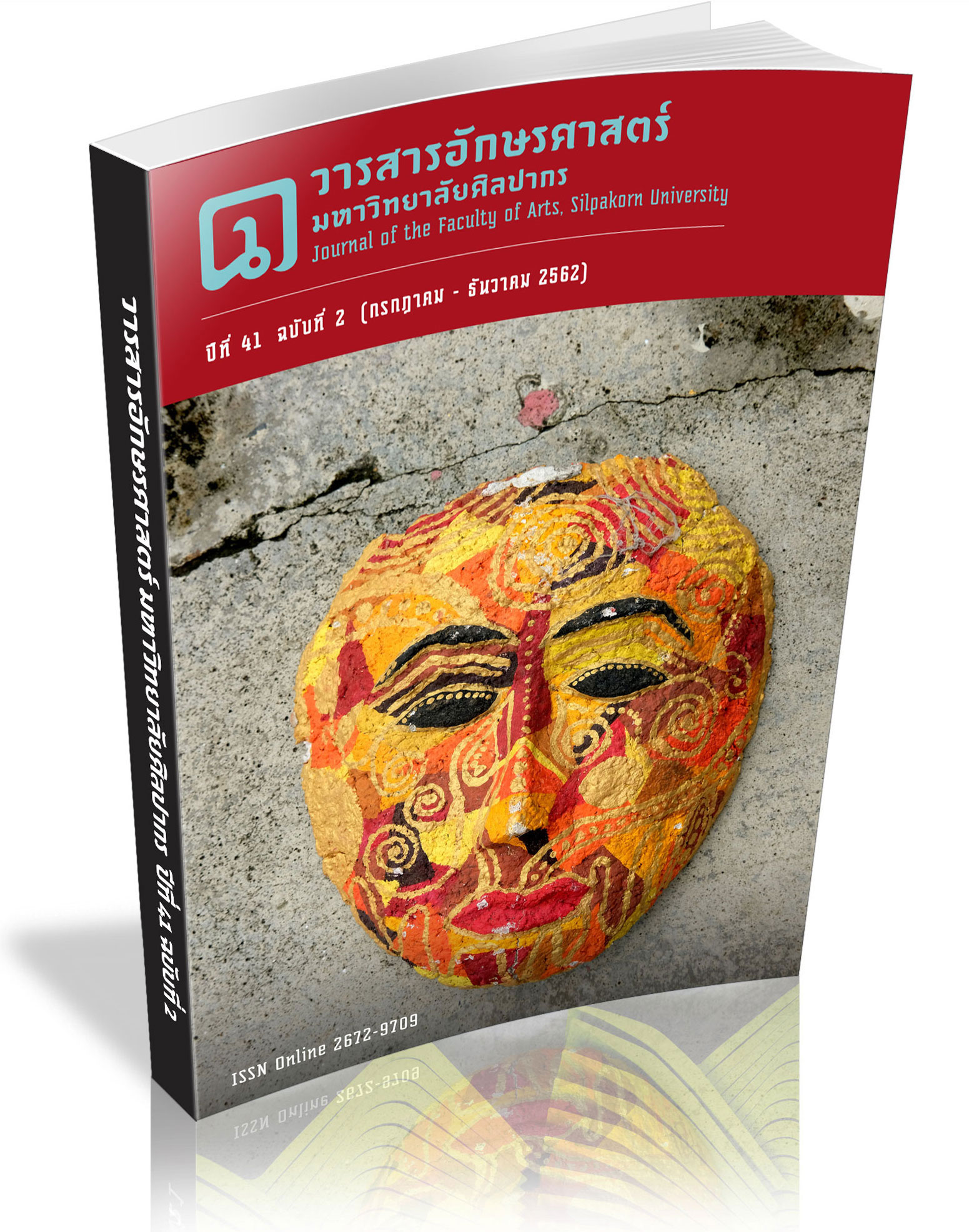Chapei Dong Veng: The Traditional Cambodian Musical Instruments
Keywords:
Chapei Dong Veng, Long-necked Kajubpi, Cambodian musical instrumentsAbstract
This article aims to study “Chapei Dong Veng” (Khmer: ចាប៉ីដងវែង), the Cambodian two stringed long-necked Kajubpi (a guitar-type instrument), with regards to its origin and role by using Indian musical culture documents which are influential to the Khmer civilization. The study found that during the period of Pre – Phra Nakhon, (the ancient city of Khmer,) and the Phra Nakhon, the appearance of “Chapey” was limited under the form of “Veena” which is the most similarities to its instrumentation. The word, Veena, has a broad meaning referring to a plucked string instrument. Under the period of disappearances. It can thus be assumed that Chapey could have been used before the Pre-Phra Nakorn Period. Moreover, the status in its orchestration as a supportive on melodic instrumentation affected its sacred use role. Unlikely, the other harp-type or the other bow-type stringed instruments that has significant appearance on the Khmer architectural outter as decoration; it has shown. Through the period of Pre- Phra Nakorn (C.9-C.15), Chaypey was still hidden. But, under the Communism party regime that ruled between 1975 and 1979, Chapei Dong Veng originally served its duty as a tool for the political propagation of the military regimes. Today, Chapei Dong Veng still maintains its role being played in Cambodian musical ensembles. And, yet, it is still played among other accompaniments in many Cambodian rites, rituals and ceremonies.
Downloads
References
Buddhasartbundit. (1971). About Cambodian music. Phnom Penh.(In Thai)
Charoensuk, S. (2018). New voices in Southeast Asia. Bangkok: Yin Yang Printing. (In Thai)
Chuawen, Y. (2016). History of Southeast Asia before modern times. Nakhon Pathom: Silpakorn University Press.(In Thai)
Deva, B. C. (1979). Musical instruments of India (A. S. B. C. Robert P.F. Lam, Trans.). Hong Kong: Urban Council.
Heywood, D. (2008). Cambodian Dance Celebration of the Gods. Thailand: Bangkok Printing.
Khian, Y. (2010). Early Cambodian musical instruments. Nonthaburi: Yin Yang Printing.(In Thai)
Kingkaew, S. (2018). Interviewed, December 2018.(In Thai)
Kingkaew, S. (2018). The culture of Thai Folk music in four regions. Nakhon Pathom: Silpakorn University Press.(In Thai)
Krishnaswami, K. (1977). Musical instrument of India. Newdelhi: the director publications division ministry of information and broadcasting bovernment of India patiala house.
Leng, S. (2018). Interviewed, December 2018.(In Thai)
Montague, J. G. (2010). Picture postcards of Cambodia, 1900-1950. Bangkok: White Lotus.
Narom, K. (2005). Cambodian Music. Phnom Penh: Reyum
Narom, K. (2011). Music and Life of Khmer. Phnom Penh: Chappunrangsri.
Phaipheng, C. & In, S. (2003). Thais-related History in Cambodian textbooks, (Phakdikham, S. translated.). Bangkok: Pikanas Center.(In Thai)
Phakdikham, S. (2003). Thais-related History in Cambodian textbooks. Bangkok: Matichon.(In Thai)
________. (2014). Khmer Art. Bangkok: Matichon.(In Thai)
Phikunsri, C. (1999). The Appreciation of Thai Music. Bangkok: Odeon Store.(In Thai)
________. (1993). Indian music. Khon Kaen: Khon Kaen University Press.(In Thai)
Sadie, S. (Ed.) (1980). The New Grove dictionary of music and Musicians (Vols. 9). London: Mc Millan.
Sam, S. (2002). Musical Instruments of Cambodia. Japan: Osaka National Museum of Ethnomusicology.
Sapphut, M. (2018). Cambodian Musical Instruments and Culture of Early Phranakhon from the stone inscription of Wat Komnu. Khon Kaen University in Music and Performance, 1 (1): 120-121.(In Thai)
Sotheara, V. (2010). Pre-angkor incriptions of Cambodia 1. PhnomPenh: Angkor.
Suksawat, S. (1994). Khmer style art in Thailand: Intellectual backgrounds and artistic styles. Bangkok: Matichon Publishing. (In Thai)
Sunpongsri, K. (2015). Indian Art History. Bangkok: Chulalongkorn University Press. (In Thai)
Suthira, W. (2012). Inscription in Cambodia during the Phra Nakhon period. Phnom Penh: Department of History. (In Thai)
Thirawit, K. & Phasuk, S. (2000). Cambodian history, society, economy, security, politics and foreign affairs. Bangkok: Institute of Asian Studies, Chulalongkorn University. (In Thai)
The Royal Society of Thailand. (2014). Dictionary of Sociology. Bangkok: Arunkarnpim. (In Thai)
________. (2018). Dictionary of Anthropology. Bangkok: Arunkarnpim. (In Thai)
Victoria & Albert Museum London. (2019). Saraswati Vina. Retrieved from https://www.vam.ac.uk/content/exhibitions/display-musical- wonders-ofindia/saraswati-vina/
Wikipedia.(2019). Chapei Dong Veng. Retrieved from https://www. https://km.wikipedia.org. (In Thai)
Downloads
Published
How to Cite
Issue
Section
License
ผู้เขียนบทความต้องยินยอมในข้อกำหนดต่าง ๆ ของวารสารก่อนส่งบทความตีพิมพ์




